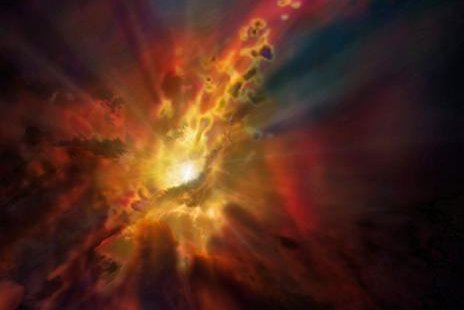1 of 2 | An artistic rendering shows cold clumps of gas clouds being pulled into the accretion disk of a supermassive black hole. Photo by NRAO/AUI/NSF/Dana Berry/SkyWorks
NEW HAVEN, Conn., June 8 (UPI) -- Until now, astronomers thought black holes are fueled almost exclusively by steady diet of hot, ionized gas. But astronomers from Yale and MIT have spotted a supermassive black hole devouring cold gas -- a first.
The new findings, detailed in the journal Nature, suggest black holes enjoy an expansive and varied diet.
"This diffuse, hot gas is available to the black hole at a low level all the time, and you can have a steady trickle of it going in," Michael McDonald, assistant professor of physics in MIT's Kavli Institute for Astrophysics and Space Research, told MIT News.
"Every now and then, you can have a rainstorm with all these droplets of cold gas, and for a short amount of time, the black hole's eating very quickly," McDonald said. "So the idea that there are these two dinner modes for black holes is a pretty nice result."
Scientists discovered the black hole while using the Atacama Large Millimeter/submillimeter Array, or ALMA, the survey the distrubution of gas across the ancient galaxy cluster Abell 2597, located 1 billion light-years away and comprising 50-odd galaxies that stretch several thousand light-years across.
While plotting the distribution of cold, condensed gas -- the kind that forms new stars -- researchers identified three gas clouds streaming toward the accretion disk of the supermassive black hole at the center of the cluster. The clouds are traveling at a speed of more than 1 million miles per hour and measure several dozen light-years across.
Researchers have suggested a cold gas meal was possible in theory, but the latest discovery offers the first hard evidence of the phenomenon.
"It's exciting to think we might actually be observing this galaxy-spanning 'rainstorm' feeding a black hole whose mass is about 300 million times that of our Sun," Grant Tremblay, lead study author and Yale astronomer, said in a news release.
"Since we know so little about the mechanics of how the AGN, active galactic nucleus, interacts with the rest of the galaxy, this is a real step forward," added study co-author Louise Edwards, also a Yale astronomer.
Researchers are now using ALMA to search for similar "rainstorms" inside other galaxies and galactic clusters.















